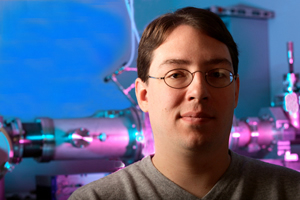Doctoral candidate takes second place at symposium with research
A graduate student with the University of Houston’s Cullen College of Engineering took second place at the 30th Semiannual Texas Center for Superconductivity at the University of Houston (TcSUH) Student Symposium for his work on nanotech-device fabrication. Barry Craver, who is pursing a Ph.D. in electrical engineering, is currently conducting research in the area of atom beam lithography.
This nanotech-fabrication technique utilizes a beam of atoms bombarding a thin stencil mask. The atoms pass through openings on that mask and expose the material sitting behind the mask, called the resist. This exposure results in impressions in the resist that can then be used to build nanotech devices in a number of ways. For instance, the impressions can be used as molds and filled with magnetic material to build nanotech sensors.
According to scientific theorists, the method can be used to build devices as small as four to five nanometers wide. Craver, under the direction of Professor John Wolfe, the inventor of atom beam lithography, and Associate Professor Dmitri Litvinov, is attempting to achieve this theoretical limit in his experiments.
“We’re very curious as to what the ultimate resolution of the atom beam lithography technique is,” said Craver. “What’s the smallest feature we can actually print? A lot of our research has been concerned with issues of how small a feature you can actually transfer onto your resist.”
At the Texas Center for Superconductivity at the University of Houston Student Symposium, Craver presented his recent efforts in this area. A panel of faculty members judged each presenter on originality and quality of research, the quality of their presentation and their use of visual aids, and awarded Craver second place.
Craver reported that he spread carbon nanotubes over the stencil mask, with many of the tubes covering parts of the openings on the mask. After bombarding the stencil mask with the atom beam, he found that the beam was not blocked by the nanotubes, but instead passed through them. When it hit the resist, though, the beam had been affected enough to leave a clear impression of the tubes. These impressions measure about 10 nanometers, some of the smallest features ever achieved through atom beam lithography.
“There’s a fundamental limit, we believe on the order of a few nanometers, that we think is the smallest you could ever print onto your resist with atom beam lithography, or any other kind of lithography,” Craver said. “You just can’t print features smaller than that because the resist material won’t allow it. We’re getting fairly close to that theoretical number with our experiments. We expect we should be able to print 4-5nm features.”
Craver plans to continue his experiments attempting to reach the theoretical limit of atom beam lithography. Most likely, he said, it will be achieved not through a large discovery, but through small adjustments in the experiments.
